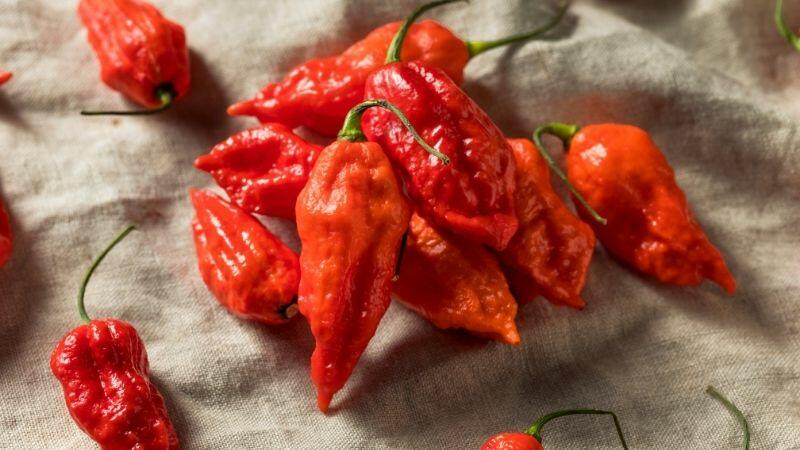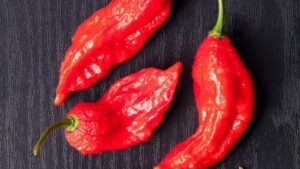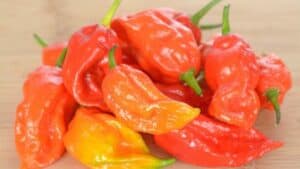Peppers like the ghost chili pack some serious
Ghost peppers create a delayed, creeping mouth burn focused on the back of the throat. Their unique heat profile and spicy compound capsaicin are why they bring the fire.
This article will explore:
- Where you feel ghost pepper heat
- Factors behind their intense burn
- How other peppers burn differently
- Tips to tame the flames
Understanding the science of ghost chili
So get ready to learn why these peppers can utterly scorch your mouth and sinuses. You’ll gain a whole new appreciation for ghost pepper heat after reading!
Let’s dig into why these iconic red peppers scorch so intensely.
Where Does Ghost Pepper Heat Localize?
Ghost pepper heat focuses on the back of the throat.
You won’t feel the burn immediately when you first bite into one. Their slow-releasing compound capsaicin takes a few seconds to activate.
This delay gives time to swallow before the spicy sensation kicks in. The rising heat then spreads from throat to tongue.
Ghost chilies earned their spooky name from this sneaky heat cascade. It’s like you’re briefly possessed before flaming up!
What Factors Create Ghost Pepper Burn?
Several elements contribute to ghost pepper mouth burn:
- Scoville units – Ghosts score over 1 million, one of the hottest ratings.
- Delayed heat – Unlike instant spices like wasabi, ghost pepper takes a while to kick in.
- Long duration – The slow burn lasts 30-45 minutes once it starts.
This unique combo makes ghost chilies scorch with a distinctive creeping fire.
Do All Spicy Peppers Burn the Same?
Not all hot peppers create equal mouth burn. The location and intensity of each chili’s
For example, habanero chilies also burn the throat, but their faster heat release localizes more to the tip of the tongue. Jalapeños focus heat on the front of the mouth.
So pepper variety plays a role in oral burn sensation. The diverse flavors complement dishes in distinct ways.
Mapping Where Different Chilies Burn
Here’s a breakdown of where you’ll feel the sizzle from common hot peppers:
- Habanero – Back of throat
- Jalapeño – Tip of tongue
- Poblano – Sides of tongue
- Cayenne – Front and middle of mouth
- Aji – Tip of tongue
- Tabasco – Lips and tongue
As you can see, there’s some overlap but also unique burn points depending on the chili.
Do Seeds Cause the Heat?
Many assume seeds contain the most heat. But capsaicin actually originates in the pith around the seeds, not the seeds themselves.
As a defense mechanism, peppers produce capsaicin in tissue surrounding the seeds. Seeds lack it naturally but absorb some from contact.
So feel free to include seeds when cooking. Just know the real fire comes from elsewhere!
How Long Does Ghost Pepper Burn Last?
One of the defining aspects of ghost peppers is the prolonged burn they produce. But just how long does the fiery sensation typically last?
On average, ghost pepper heat lasts 30-45 minutes once it kicks in. However, the exact duration depends on several factors:
- Scoville rating – The higher the units, the longer the burn. Ghosts range from 800,000 to over 1 million.
- Amount consumed – Eating more ghost pepper leads to more extended burn. Even small amounts pack a punch though.
- Tolerance – People used to spicy food may experience shorter duration. The heat-sensitive will sizzle longer.
- Milk – Dairy protein casein binds to capsaicin and can shorten burn time.
- Fats – High-fat foods like oils prolong mouth burn.
So while ghosts reliably torch for half an hour or more, personal tolerance and what you eat them with impact the experience.
Some claim ghost pepper heat lasts up to 1-2 hours in extreme cases. But most find the worst has passed after 45 minutes with proper precautions.
Drinking milk is the best way to find relief once the ghost pepper burn becomes too much to bear.
How to Eat a Ghost Pepper Without Burning
Ghost peppers are infamous for their mouth-scorching
- Drink milk – The casein protein binds to capsaicin to block receptors. Milk is the most effective remedy.
- Eat slowly – Don’t swallow right away so the spiciness can dissipate on your tongue. Avoid reaching the throat.
- Add starch – Breads, rice, and starchy foods soak up some of the pepper’s oils.
- Coat with fat – High-fat foods like oil or cheese coat your mouth to minimize burn.
- Cut open – Scoop out seeds and pith to remove most of the capsaicin.
- Develop tolerance – Regular low-dose exposure will build your heat resilience over time.
While these tips can help take the edge off, ghost peppers will always have serious
FAQs
Do ghost peppers actually burn your mouth?
Not directly. It’s your brain’s interpretation of the capsaicin interaction that creates the sensation of burning.
What if you swallow a ghost pepper whole?
Skipping mouth contact prevents oral burn, but you risk gut irritation as capsaicin releases during digestion.
How can you prevent ghost pepper mouth burn?
Consuming slowly, drinking milk, and eating starchy foods can all help temper ghost pepper
The Takeaway
Thanks to their delayed, creeping mouth burn, ghost peppers torch tastebuds like no other. Understanding their heat profile helps you better enjoy their extreme






We make our own salsa with 2 Ghost peppers and 1 Carolina reaper for 4 qts of salsa. We just use the meat of the peppers for our salsa. Very good !